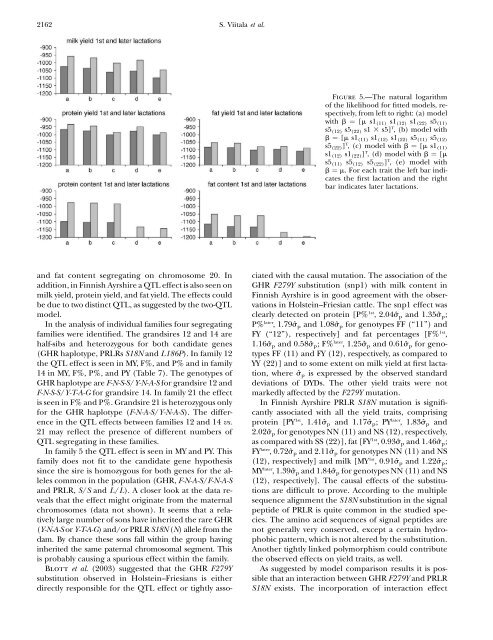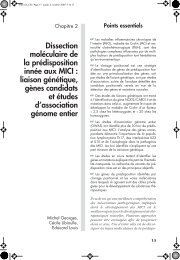2162 S. Viitala et al.Figure 5.—<strong>The</strong> natural logarithm<strong>of</strong> <strong>the</strong> likelihood for fitted models, respectively,from left to right: (a) modelwith b ¼ [m s1 (11) s1 (12) s1 (22) s5 (11)s5 (12) s5 (22) s1 3 s5] T , (b) model withb ¼ [m s1 (11) s1 (12) s1 (22) s5 (11) s5 (12)s5 (22) ] T , (c) model with b ¼ [m s1 (11)s1 (12) s1 (22) ] T , (d) model with b ¼ [ms5 (11) s5 (12) s5 (22) ] T , (e) model withb ¼ m. For each trait <strong>the</strong> left bar indicates<strong>the</strong> first lactation <strong>and</strong> <strong>the</strong> rightbar indicates later lactations.<strong>and</strong> fat content segregating on chromosome 20. Inaddition, in Finnish Ayrshire a QTL effect is also seen onmilk yield, protein yield, <strong>and</strong> fat yield. <strong>The</strong> effects couldbe due to two distinct QTL, as suggested by <strong>the</strong> two-QTLmodel.In <strong>the</strong> analysis <strong>of</strong> individual families four segregatingfamilies were identified. <strong>The</strong> gr<strong>and</strong>sires 12 <strong>and</strong> 14 arehalf-sibs <strong>and</strong> heterozygous for both c<strong>and</strong>idate genes(GHR haplotype, PRLRs S18N <strong>and</strong> L186P). In family 12<strong>the</strong> QTL effect is seen in MY, F%, <strong>and</strong> P% <strong>and</strong> in family14 in MY, F%, P%, <strong>and</strong> PY (Table 7). <strong>The</strong> genotypes <strong>of</strong>GHR haplotype are F-N-S-S/Y-N-A-S for gr<strong>and</strong>sire 12 <strong>and</strong>F-N-S-S/Y-T-A-G for gr<strong>and</strong>sire 14. In family 21 <strong>the</strong> effectis seen in F% <strong>and</strong> P%. Gr<strong>and</strong>sire 21 is heterozygous onlyfor <strong>the</strong> GHR haplotype (F-N-A-S/Y-N-A-S). <strong>The</strong> differencein <strong>the</strong> QTL effects between families 12 <strong>and</strong> 14 vs.21 may reflect <strong>the</strong> presence <strong>of</strong> different numbers <strong>of</strong>QTL segregating in <strong>the</strong>se families.In family 5 <strong>the</strong> QTL effect is seen in MY <strong>and</strong> PY. Thisfamily does not fit to <strong>the</strong> c<strong>and</strong>idate gene hypo<strong>the</strong>sissince <strong>the</strong> sire is homozygous for both genes for <strong>the</strong> allelescommon in <strong>the</strong> population (GHR, F-N-A-S/F-N-A-S<strong>and</strong> PRLR, S/S <strong>and</strong> L/L). A closer look at <strong>the</strong> data revealsthat <strong>the</strong> effect might originate from <strong>the</strong> maternalchromosomes (data not shown). It seems that a relativelylarge number <strong>of</strong> sons have inherited <strong>the</strong> rare GHR(Y-N-A-S or Y-T-A-G) <strong>and</strong>/or PRLR S18N (N)allelefrom<strong>the</strong>dam. By chance <strong>the</strong>se sons fall within <strong>the</strong> group havinginherited <strong>the</strong> same paternal chromosomal segment. Thisis probably causing a spurious effect within <strong>the</strong> family.Blott et al. (2003) suggested that <strong>the</strong> GHR F279Ysubstitution observed in Holstein–Friesians is ei<strong>the</strong>rdirectly responsible for <strong>the</strong> QTL effect or tightly associatedwith <strong>the</strong> causal mutation. <strong>The</strong> association <strong>of</strong> <strong>the</strong>GHR F279Y substitution (snp1) with milk content inFinnish Ayrshire is in good agreement with <strong>the</strong> observationsin Holstein–Friesian cattle. <strong>The</strong> snp1 effect wasclearly detected on protein [P% 1st , 2.04ŝ p <strong>and</strong> 1.35ŝ p ;P% later , 1.79ŝ p <strong>and</strong> 1.08ŝ p for genotypes FF (‘‘11’’) <strong>and</strong>FY (‘‘12’’), respectively] <strong>and</strong> fat percentages [F% 1st ,1.16ŝ p <strong>and</strong> 0.58ŝ p ;F% later , 1.25ŝ p <strong>and</strong> 0.61ŝ p for genotypesFF (11) <strong>and</strong> FY (12), respectively, as compared toYY (22)] <strong>and</strong> to some extent on milk yield at first lactation,where ŝ p is expressed by <strong>the</strong> observed st<strong>and</strong>arddeviations <strong>of</strong> DYDs. <strong>The</strong> o<strong>the</strong>r yield traits were notmarkedly affected by <strong>the</strong> F279Y mutation.In Finnish Ayrshire PRLR S18N mutation is significantlyassociated with all <strong>the</strong> yield traits, comprisingprotein [PY 1st , 1.41ŝ p <strong>and</strong> 1.17ŝ p ;PY later , 1.83ŝ p <strong>and</strong>2.02ŝ p for genotypes NN (11) <strong>and</strong> NS (12), respectively,as compared with SS (22)], fat [FY 1st , 0.93ŝ p <strong>and</strong> 1.46ŝ p ;FY later , 0.72ŝ p <strong>and</strong> 2.11ŝ p for genotypes NN (11) <strong>and</strong> NS(12), respectively] <strong>and</strong> milk [MY 1st , 0.91ŝ p <strong>and</strong> 1.22ŝ p ;MY later , 1.39ŝ p <strong>and</strong> 1.84ŝ p for genotypes NN (11) <strong>and</strong> NS(12), respectively]. <strong>The</strong> causal effects <strong>of</strong> <strong>the</strong> substitutionsare difficult to prove. According to <strong>the</strong> multiplesequence alignment <strong>the</strong> S18N substitution in <strong>the</strong> signalpeptide <strong>of</strong> PRLR is quite common in <strong>the</strong> studied species.<strong>The</strong> amino acid sequences <strong>of</strong> signal peptides arenot generally very conserved, except a certain hydrophobicpattern, which is not altered by <strong>the</strong> substitution.Ano<strong>the</strong>r tightly linked polymorphism could contribute<strong>the</strong> observed effects on yield traits, as well.As suggested by model comparison results it is possiblethat an interaction between GHR F279Y <strong>and</strong> PRLRS18N exists. <strong>The</strong> incorporation <strong>of</strong> interaction effect
GHR <strong>and</strong> PRLR Genes in Milk Production 2163into <strong>the</strong> model markedly influenced estimates <strong>of</strong> marginalSNP effects. On <strong>the</strong> o<strong>the</strong>r h<strong>and</strong>, because <strong>of</strong> lowfrequencies <strong>of</strong> genotypes with <strong>the</strong> less frequent allele,we anticipate that in our family data <strong>the</strong> power <strong>of</strong>detecting interaction <strong>and</strong> proper partitioning betweenmarginal <strong>and</strong> interaction effects is very low.In our family data seven sires are heterozygous forPRLR S18N but <strong>the</strong> QTL effect is segregating in only two<strong>of</strong> <strong>the</strong>se families. In <strong>the</strong>se families <strong>the</strong> sires are heterozygousalso for <strong>the</strong> GHR F279Y <strong>and</strong> thus one explanationcould be that <strong>the</strong> second QTL acts only as a modifier <strong>of</strong><strong>the</strong> first QTL so is detectable only through a model withQTL interaction.<strong>The</strong> association <strong>of</strong> GHR F279Y <strong>and</strong> PRLR S18N polymorphismwith milk production traits was confirmed onan independent sample <strong>of</strong> progeny-tested bulls (dataset II) not included in <strong>the</strong> family data. <strong>The</strong> result clearlymimics <strong>the</strong> genetic effects observed in data set I: <strong>the</strong>effect <strong>of</strong> PRLR S18N (snp5) predominates on yield traits<strong>and</strong> that <strong>of</strong> GHR F279Y (snp1) on content traits. <strong>The</strong>model with interaction terms is selected as a best modelin most <strong>of</strong> <strong>the</strong> traits.Blott et al. (2003) concluded that it is unlikely that<strong>the</strong> F279Y or tightly associated polymorphism accountsfor <strong>the</strong> entire chromosome 20 QTL effect in <strong>the</strong>Holstein–Friesian population. We herein suggest thatPRLR S18N or a polymorphism in strong LD with PRLRS18N is partly responsible for <strong>the</strong> effect seen in milktraits in Finnish Ayrshire. However, we cannot exclude<strong>the</strong> possibility that also additional loci are involved inchromosome 20 QTL effect.In this study <strong>the</strong> main focus is on <strong>the</strong> coding region<strong>of</strong> GHR <strong>and</strong> PRLR. In both cases <strong>the</strong> coding sequenceis only a minor part <strong>of</strong> <strong>the</strong> 80- to 100-kb gene, <strong>and</strong><strong>the</strong>refore <strong>the</strong> majority <strong>of</strong> <strong>the</strong> sequence remains unanalyzed.If <strong>the</strong> genomic orientation <strong>of</strong> bovine GHR <strong>and</strong>PRLR genes corresponds to <strong>the</strong> orientation <strong>of</strong> <strong>the</strong>human <strong>and</strong> mouse genes, <strong>the</strong>n it is possible that in <strong>the</strong>bovine genome <strong>the</strong> 59-untranslated regions <strong>of</strong> GHR <strong>and</strong>PRLR are facing on opposite str<strong>and</strong>s, at 7 Mb distancefrom each o<strong>the</strong>r. <strong>The</strong> 59 regulatory region <strong>of</strong> GHR islarge (.30 kb). For example, in bovine GHR threealternative promoters with untranslated exons have beenwell characterized (Hauser et al. 1990; Heap et al. 1996;Lucy et al. 1998; Jiang et al. 1999) <strong>and</strong> <strong>the</strong> existence <strong>of</strong>six o<strong>the</strong>r variants has been suggested (Jiang <strong>and</strong> Lucy2001). In this study we have sequenced <strong>the</strong> three wellcharacterizedpromoters <strong>of</strong> GHR without finding anysequence polymorphism in Finnish Ayrshire. Even though<strong>the</strong> majority <strong>of</strong> <strong>the</strong> GHR <strong>and</strong> PRLR sequences still needto be analyzed it is possible that o<strong>the</strong>r genes are atleast partly responsible for <strong>the</strong> effect. In <strong>the</strong> human genomicsequence <strong>the</strong>re are still tens <strong>of</strong> genes betweenGHR <strong>and</strong> PRLR, some with known <strong>and</strong> some withunknown functions.An interesting fact pointed out by Blott et al. (2003)is that <strong>the</strong> administration <strong>of</strong> growth hormone in lactatingcows affects mainly protein yield. <strong>The</strong> F279Y mutationis associated with milk yield, protein percentage,<strong>and</strong> fat percentage in Finnish Ayrshire but not withprotein yield. An association between yield traits <strong>and</strong>PRLR S18N was, however, observed. Both GH <strong>and</strong> PRLare essential hormonal factors regulating <strong>the</strong> development<strong>and</strong> differentiation <strong>of</strong> functional mammary gl<strong>and</strong>(reviewed by Kelly et al. 2002). <strong>The</strong> genes encodingPRL <strong>and</strong> GH have evolved from a common ancestralgene <strong>and</strong> <strong>the</strong>ir receptors (PRLR, GHR) are also closelyrelated. <strong>The</strong>se multifunctional hormones <strong>and</strong> <strong>the</strong>irreceptors have numerous actions <strong>and</strong> very complicatedregulation. Even though GH <strong>and</strong> PRL have clear <strong>and</strong>distinct hormonal functions <strong>the</strong>re appears to be extensiveoverlap in many respects (reviewed by Bole-Feysotet al. 1998 <strong>and</strong> Frank 2001). Interesting features make ittempting to speculate about <strong>the</strong> potential role <strong>of</strong> GH<strong>and</strong>/or PRL receptors in <strong>the</strong> observed associations.In <strong>the</strong> mammary gl<strong>and</strong>, PRL is <strong>the</strong> hormone primarilyresponsible for <strong>the</strong> syn<strong>the</strong>sis <strong>of</strong> milk proteins, lactose,<strong>and</strong> lipids, all major components <strong>of</strong> milk (see Bole-Feysot et al. 1998). This could <strong>of</strong>fer an explanation for<strong>the</strong> observed association with yield. <strong>The</strong> osmotic nature<strong>of</strong> milk lactose on <strong>the</strong> o<strong>the</strong>r h<strong>and</strong> <strong>of</strong>fers a temptingexplanation for <strong>the</strong> effect on milk yield <strong>and</strong> percentagetraits, because <strong>the</strong> percentage traits might reflect <strong>the</strong>amount <strong>of</strong> water in milk as <strong>the</strong> increase in milk watercontent decreases <strong>the</strong> proportion <strong>of</strong> milk solids. This is<strong>of</strong> course highly speculative.We herein report new evidence that <strong>the</strong> QTL effectson milk production traits on chromosome 20 in a FinnishAyrshire population can be explained by variation intwo distinct genes, GHR <strong>and</strong> PRLR. <strong>The</strong> result <strong>of</strong> ourmultimarker regression analysis suggests that in FinnishAyrshire two QTL segregate on <strong>the</strong> chromosomal regionincluding GHR <strong>and</strong> PRLR. Two substitutions showed anassociation with milk production traits: <strong>the</strong> previouslyreported F-to-Y substitution in <strong>the</strong> transmembrane domain<strong>of</strong> GHR <strong>and</strong> an S-to-N substitution at position 18 in<strong>the</strong> signal peptide <strong>of</strong> PRLR. <strong>The</strong> results provide strongevidence that <strong>the</strong> effect <strong>of</strong> PRLR S18N substitution isdistinct from <strong>the</strong> GHR F279Y effect. In particular, GHRF279Y has <strong>the</strong> highest influence on protein percentage<strong>and</strong> fat percentage while PRLR S18N markedly influencesprotein <strong>and</strong> fat yield. In addition, association analysissuggests interaction between <strong>the</strong>se two substitutions.We herein suggest that <strong>the</strong> observed substitutions areei<strong>the</strong>r directly responsible for <strong>the</strong> QTL effect or tightlyassociated with causal mutation.This work was funded by <strong>the</strong> Ministry <strong>of</strong> Agriculture <strong>and</strong> Forestry <strong>of</strong>Finl<strong>and</strong> (grant 5100/39/98), <strong>the</strong> European Union (grant BIO4-98-0471), <strong>and</strong> <strong>the</strong> Finnish Animal Breeding Association.LITERATURE CITEDArranz, J.-J., W. Coppieters, P.Berzi, N.Cambisano, B.Grisartet al., 1998 A QTL affecting milk yield <strong>and</strong> composition maps



